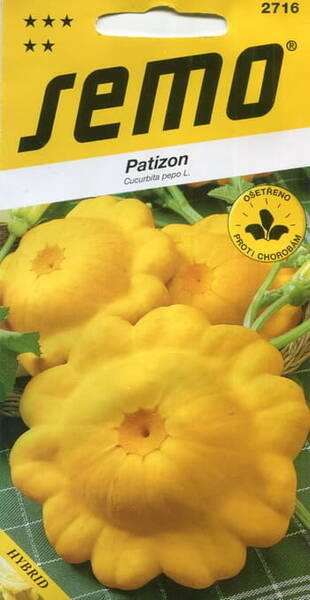The variety is early ripening (from germination to the beginning of fruiting 40 45 days). Bush plant. The fruit is disc-shaped with jagged edges, yellow-orange, weighing 0.4-0.5 kg. The pulp is white and juicy.
Productivity: 2.0-3.2 kg/m2.
Agricultural technology.
Squash is grown on light soils, where potatoes, cabbage, onions and legumes grew in the previous year.
Before sowing, the seeds are treated in a solution of potassium permanganate, then washed with clean water. Sowing in open ground and film shelters approximately in May, when the soil warms up to a depth of 8-10 cm to + 13 + 14 ° C, according to the scheme 100x70 cm. Seeds are sown in holes of 2-3 pieces to a depth of 5-6 cm.
After germination, weak plants must be removed.
The seedling method of cultivation is also used. In this case, seedlings with 2-3 true leaves are planted after preliminary hardening, one per hole, after the threat of frost has passed.
Further care consists of regular loosening, weeding, watering and top dressing.
Eng.: Scallop squash. Bot.: Cucurbita pepo L. var. melopepo.
* Patisson comes from Central and South America. Widely grown in France, USA. This is a type of hard-skinned gourd. It has been grown in Russia since the middle of the 19th century.
In recent years, more and more often appears on the beds of vegetable growers. It is grown less than zucchini, as the patisson is more demanding in growing conditions.
Patisson is a herbaceous plant of the gourd family. Does not form lashes, but forms a bush. The fruits of the squash have a variety of shapes, but most often they resemble plates, which is why the squash is also called a plate gourd. Squash is less productive and more thermophilic than zucchini. At +2°C plants die.
To taste, patissons resemble asparagus and artichoke, and in canned form - porcini mushrooms.
Fruit pulp contains sugars, vitamin C, pectin and provitamins A, B1, B2, PP. Squash stew, salt and marinate. They are also grown for decorative purposes - the fruits, similar to plates, are very beautiful.
The fruits of squash are useful for obesity, anaemia, kidney disease, hypertension, atherosclerosis, and cardiovascular diseases. Squash seeds begin to germinate at a temperature of +12+15°C.
Quickly germinate at +25+27°C. It grows well at a temperature of +18+25°C. The stem of the squash is short - 50-150 cm. It is mainly a bush plant, it does not give lateral shoots. Blooms and forms ovaries until frost.
The bark of fruits in technical ripeness is soft and white. When ripe, the bark becomes woody. Previously, squash varieties were only with white fruits. And now varieties with fruits of yellow and orange colour have been created. These varieties contain carotene. There are varieties with bright and dark green fruits.
Patissons are pollinated with pumpkins and zucchini. As a result of such crossing, new plants appeared: patichok (a hybrid of squash and squash), pumpkin (a hybrid of pumpkin and squash) and pumpkin (a hybrid of pumpkin and squash). Patissons are demanding lighting conditions. They grow poorly in partial shade, under trees, the yield decreases and the quality of the fruit deteriorates.
The yield also decreases with the thickening of plantings. In this case, rot can develop and fruits can be affected. In order to ventilate the plantings, it is recommended to cut out part of the leaves.
Patisson is a moisture-loving culture. In hot weather, they need to be watered abundantly (usually every other day). Rarely watered in cool weather. Plants should be watered with warm water to prevent root rot.
The soil for squash requires light, fertile, water and breathable, with a neutral reaction. They do not grow well in acidic, clay soils. Lime (200-300 g/sq.m) is best applied under the previous crop.
Clay soils need to be enriched with loosening materials - peat, humus, rotted sawdust and compost. Requirements for the conditions of mineral nutrition vary depending on the phase of plant development. A lot of nitrogen is needed at the stage of leaf growth and more phosphorus and potassium are required during fruit formation...












